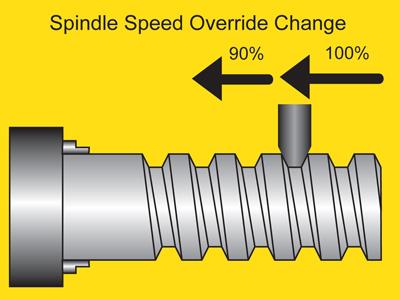
FANUC America Corp. offers the arbitrary speed threading option on 0i-TD and 0i Mate-TD CNCs for new turning machines. Arbitrary speed threading enables the operator to adjust the spindle speed during thread cutting to control chatter, and it also provides the functionality to quickly rethread or repair existing threads. This makes it ideal for oil and gas industry pipe and fitting thread maintenance.
Arbitrary speed threading allows the operator to adjust the spindle speed during a threading cycle to eliminate vibration and chatter. This is an invaluable feature for thread repair as chatter is more likely to occur with the small amounts of material typically being removed. Without arbitrary speed threading, the spindle speed override is inhibited during threading. This is to prevent damaging the part, as a change in thread lead would occur. The arbitrary speed threading function ensures that the cutting tool remains coordinated with the spindle speed at all times during threading to produce the programmed lead.
Arbitrary speed threading also provides the functionality to pick up and repair an existing thread, making it fast to set up, easy to use and quick to reproduce original threads. The process of repairing threads can be simplified further for operators by using FANUC's MANUAL GUIDE i conversational programming. Without any knowledge of G-code, the operator uses straight forward graphical screens to answer simple questions to generate a suitable thread repair program.
Arbitrary speed threading can be used with constant lead threading, threading cycle and multiple threading cycle. In addition to repetitive machining, the same thread shape can be machined even if the spindle speed is changed between roughing and finishing passes. Cs contour control is required for this function.
Arbitrary speed automates the rethreading process that used to be a highly skilled manual process. The increased productivity gained from this option is ideal for the oil and gas industry where threading large diameter or long length workpieces and pipe rethreading or repair is common. When purchasing a new turning machine, specify arbitrary speed threading option on the FANUC CNC to the machine tool builder or distributor. Arbitrary speed threading was previously introduced for the FANUC Series 30i-B and 30i-A CNCs.
Contact Details
Related Glossary Terms
- chatter
chatter
Condition of vibration involving the machine, workpiece and cutting tool. Once this condition arises, it is often self-sustaining until the problem is corrected. Chatter can be identified when lines or grooves appear at regular intervals in the workpiece. These lines or grooves are caused by the teeth of the cutter as they vibrate in and out of the workpiece and their spacing depends on the frequency of vibration.
- computer numerical control ( CNC)
computer numerical control ( CNC)
Microprocessor-based controller dedicated to a machine tool that permits the creation or modification of parts. Programmed numerical control activates the machine’s servos and spindle drives and controls the various machining operations. See DNC, direct numerical control; NC, numerical control.
- conversational programming
conversational programming
Method for using plain English to produce G-code file without knowing G-code in order to program CNC machines.
- threading
threading
Process of both external (e.g., thread milling) and internal (e.g., tapping, thread milling) cutting, turning and rolling of threads into particular material. Standardized specifications are available to determine the desired results of the threading process. Numerous thread-series designations are written for specific applications. Threading often is performed on a lathe. Specifications such as thread height are critical in determining the strength of the threads. The material used is taken into consideration in determining the expected results of any particular application for that threaded piece. In external threading, a calculated depth is required as well as a particular angle to the cut. To perform internal threading, the exact diameter to bore the hole is critical before threading. The threads are distinguished from one another by the amount of tolerance and/or allowance that is specified. See turning.
- turning
turning
Workpiece is held in a chuck, mounted on a face plate or secured between centers and rotated while a cutting tool, normally a single-point tool, is fed into it along its periphery or across its end or face. Takes the form of straight turning (cutting along the periphery of the workpiece); taper turning (creating a taper); step turning (turning different-size diameters on the same work); chamfering (beveling an edge or shoulder); facing (cutting on an end); turning threads (usually external but can be internal); roughing (high-volume metal removal); and finishing (final light cuts). Performed on lathes, turning centers, chucking machines, automatic screw machines and similar machines.
- turning machine
turning machine
Any machine that rotates a workpiece while feeding a cutting tool into it. See lathe.
